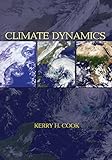Climate dynamics Kerry Harrison Cook
Tipo de material: Libro
impreso(a)
Idioma: Inglés Detalles de publicación: Princeton, New Jersey, United State Princeton University Press c2013Descripción: xii, 200 páginas ilustraciones, mapas, gráficas 26 centímetrosISBN:
Libro
impreso(a)
Idioma: Inglés Detalles de publicación: Princeton, New Jersey, United State Princeton University Press c2013Descripción: xii, 200 páginas ilustraciones, mapas, gráficas 26 centímetrosISBN: - 0691125309
- 9780691125305
- 551.6 C6
Incluye bibliografía e índice
Preface.. Chapter 1 An Introduction to the Climate System.. Reference and Additional Reading.. Chapter 2 The Observed Climatology.. 2.1 The Atmosphere.. 2.2 The Ocean.. 2.3 The Hydrologic Cycle.. 2.4 The Cryosphere.. 2.5 The Biosphere.. 2.6 Data Sources and References.. 2.7 Exercises.. Chapter 3 Observations of Natural Climate Variability.. 3.1 Diurnal and Seasonal Climate Variations.. 3.2 Intraseasonal Climate Variability.. 3.3 Interannual Climate Variability.. 3.4 Decadal Climate Variability.. 3.5 Climate Variations on Century to Billion-Year Time Scales.. 3.6 Additional Reading.. Chapter 4 Radiative Processes in the Climate System.. 4.1 Blackbody Theory.. 4.2 Application of Blackbody Theory to the Earth System.. 4.3 How Constant Is the Solar Constant?.. 4.4 Solar and Terrestrial Spectra.. 4.5 The Greenhouse Effect.. 4.6 The Equation of Transfer.. 4.7 Radiative Effects of Clouds.. 4.8 References.. 4.9 Exercises.. Chapter 5 Thermodynamics and the Flow of Heat through the Climate System.. 5.1 Equations of State.. 5.2 The First Law of Thermodynamics.. 5.3 Heat Balance Equations.. 5.4 Observed Heat Fluxes.. 5.5 Additional Reading.. 5.6 Exercises.. Chapter 6 Dynamics: The Forces That Drive Atmospheric and Ocean Circulations.. 6.1 The Coriolis Force.. 6.2 Pressure Gradient Force.. 6.3 Hydrostatic Balance.. 6.4 Geostrophic Balance.. 6.5 Friction.. 6.6 The Momentum Equations.. 6.7 Exercises.. Chapter 7 Atmospheric Circulations.. 7.1 Thermally Direct Circulations.. 7.2 Midlatitude Circulation Systems.. 7.3 Exercises.. Chapter 8 Ocean Circulation Systems.. 8.1 Wind-Driven Circulation: Ekman Dynamics.. 8.2 The Density-Driven Circulation: The Thermohaline Circulation.. 8.3 Vertical Mixing Processes.. 8.4 Reference.. 8.5 Exercises.. Chapter 9 The Hydrologic Cycle.. 9.1 Atmospheric Water Balance.. 9.2 Land Surface Water Balance.. 9.3 Exercises.. Chapter 10 Radiative Forcing of Climate Change.. 10.1 The Atmosphere's Changing Chemical Composition.. 10.2 Radiative Effects of Greenhouse Gas Increases.. 10.3 Exercises.. Chapter 11 Climate Change Processes.. 11.1 Climate Sensitivity.. 11.2 Climate Feedback Processes.. 11.3 Extreme Hydrologic Events.. 11.4 Exercises.. Chapter 12 Climate Simulation and Prediction.. 12.1 Zero-Dimensional Climate Model.. 12.2 Surface Heat Balance Climate Models.. 12.3 General Circulation Models.. 12.4 Regional Climate Models.. 12.5 Earth System Models.. 12.6 Evaluating Model Uncertainty.. 12.7 Reference and Additional Reading.. 12.8 Exercises.. Appendix A Units, Constants, and Conversions.. Appendix B Coordinate Systems.. Local Cartesian Coordinates.. Earth-Centered Spherical Coordinates.. Appendix C Lagrangian and Eulerian Derivatives.. Index
Climate Dynamics is an advanced undergraduate-level textbook that provides an essential foundation in the physical understanding of the earth's climate system. The book assumes no background in atmospheric or ocean sciences and is appropriate for any science or engineering student who has completed two semesters of calculus and one semester of calculus-based physics. Describing the climate system based on observations of the mean climate state and its variability, the first section of the book introduces the vocabulary of the field, the dependent variables that characterize the climate system, and the typical approaches taken to display these variables. The second section of the book gives a quantitative understanding of the processes that determine the climate state--radiation, heat balances, and the basics of fluid dynamics. Applications for the atmosphere, ocean, and hydrological cycle are developed in the next section, and the last three chapters of the book directly address global climate change. Throughout, the textbook makes connections between mathematics and physics in order to illustrate the usefulness of mathematics, particularly first-year calculus, for predicting changes in the physical world. Climate change will impact every aspect of life in the coming decades. This book supports and broadens understanding of the dynamics of the climate system by offering a much-needed introduction that is accessible to any science, math, or engineering student. Makes a physically based, quantitative understanding of climate change accessible to all science, engineering, and mathematics undergraduates -Explains how the climate system works and why the climate is changing -Reinforces, applies, and connects the basic ideas of calculus and physics -Emphasizes fundamental observations and understanding -An online illustration package and solutions manual for professors is available Inglés


